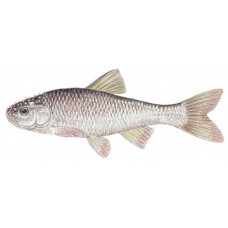Latin name
Luxilus cornutus
Other names
No information
Identification
The common shiner is silvery with a deeply compressed body, a dark dorsal stripe, large eyes, diamond-shaped scales that shed easily, and nine anal rays. It has no barbs and no dark lateral stripe, but it does have a dark stripe down the center of its back that is olive in color. During the spawning season, the males' backs turn blue, the bodies red or pink, the fins pinkish, and large tubercles appear on the head, pectoral fins, and front of the body.
Distribution
This species is found in the Mississippi River, Hudson Bay, Great Lakes and Atlantic Ocean basins from Nova Scotia to Saskatchewan, south to Missouri and Virginia.
Habitat
Common shiners are most common in small and temperate streams, preferring clear areas without fast moving water. They tolerate small amounts of silt, but not muddy water.
Size
Common shiners are usually 3-4 inches long, but can grow up to 8 inches.
Life history and Behavior
Common shiners spawn in late spring when water temperatures are between 60° and 65°F. They are versatile spawners, preferring to use the nests of other minnows such as chub and fallfish, but will also spawn on gravel or in excavated depressions in gravel or sand. Groups of males gather at the spawning site and compete for space at the top of the nest. Spawning occurs when the male wraps his body around the female and drives her to the nest. Because they often spawn in nests built by other minnow species, hybridization is common.
Food and feeding habits
Common shiners feed primarily on insects and insect larvae, but may also eat plant material, fish eggs, and small fish.
Reproduction
No information
| Classification | |
| Phylum | Chordata |
| Class | Actinopterygii |
| Squad | Cypriniformes |
| Family | Cyprinidae |
| Genus | Luxilus |
| Species | L. cornutus |
| Features | |
| Conservation status | Least Concern |
| Habitat | Pelagic |
| Life span, years | 6 |
| Maximum body weight, kg | No information |
| Maximum length, cm | 20.32 |
| Sailing speed, m/s | No information |
| Threat to people | Edible |
| Way of eating | Predator |


